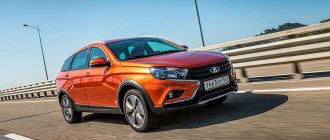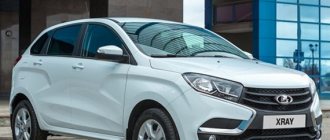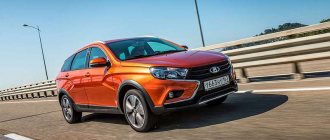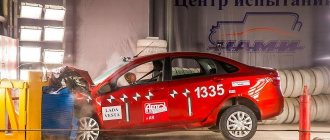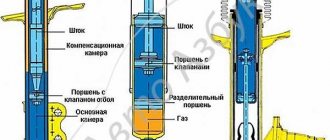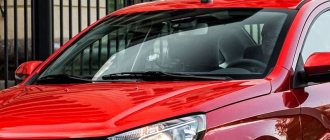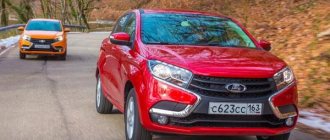Basic version and options
The initial equipment of the Renault Sandero Stepway looks like this: 82 hp, “mechanics”, audio preparation, 2 electric windows, electrically adjustable heated mirrors, 2 airbags, ABS and EBD systems.
Air conditioning will be supplied for an additional payment of 26,000 rubles, a heated windshield - for 4,500 rubles, an audio system with 4 speakers and a steering column joystick - for 9,550 rubles, and a navigation system - for 14,500 rubles. The “Chinese” traditionally take with generosity: already in the initial configuration, both the “mechanical” 94-horsepower Geely MK Cross and the “robotic” 105-horsepower Brilliance H230 delight with air conditioning, an audio system with 6 speakers, electric mirrors (Geely has more and heating), 4 power windows, 2 airbags and ABS and EBD systems.
In addition to this, Gili already has 16-inch alloy wheels as standard, and for an additional payment of 20,000 rubles you can get a leather interior and a sunroof. Chery IndiS is a little more modest in its base (air conditioning, “music” with 2 speakers, 2 power windows, 2 airbags, ABS and EBD), but in more expensive versions it almost catches up with other representatives of the Middle Kingdom.
In what configurations are they present on the market?
The price of Lada Vesta is slightly lower than that of its competitor. You can buy a Russian new product at a price of 515 thousand rubles, and in order to buy an excellent Solaris, which is a real bestseller, you need to have about 550,000 rubles in your pocket. Buyers will have to pay significantly extra to have a “robot.” By choosing Lada Vesta or Hyundai Solaris, the owner will not be disappointed if he is planning to buy a car for traveling around the city and on the highway. The warranty for a foreign car is five years, for Vesta – three years.
The basic equipment of a Russian car is somewhat more varied, which makes its purchase more tempting. However, while the Hyundai Solaris has a more powerful engine and a six-speed automatic transmission, it is the most popular class B product. Reviews in 2020 are increasingly equating these two models, as the Lada Vesta is progressing very quickly in trim levels (coupe, station wagon).
in Lada Vesta 10/06/2020 1,
For a certain period, the undisputed leaders in popularity on the Russian market and in the CIS countries were Skoda Rapid, Hyundai Solaris, Kia Rio and some other brands. With the start of sales of the domestic production car Lada Vesta, the situation has changed somewhat. The new product has provided considerable competition to many budget foreign cars in its segment.
New Lada: How to remove the airbag from the Largus steering wheel - Car portal AutoMotoGid
A logical question now arises for car enthusiasts: which car to choose from the list of competitors. Let's compare the Lada Vesta with foreign cars of the same segment. What is better to choose – already proven cars or the dynamic and bright Vesta.
Body and representativeness of models
Korean concerns have recently begun to show steady growth in the field of car prestige and stand on a par with German and Japanese cars. AvtoVAZ creations also strive for these heights, wanting to demonstrate similar representativeness of their latest development. If you compare the Lada Vesta and the Hyundai Solaris based on the first impression and the status that they show, you cannot say for sure which is better.
In terms of dimensions, the following indicators can be distinguished, given in the passport documents of both models:
- the height of the Lada Vesta is 1497, the Hyundai is 3 cm lower;
- the Russian new product is slightly longer 4410 vs 4375;
- Hyundai loses in terms of body width: 1.7 m versus 1765 mm;
- trunk volume is almost equal – 470 and 480 kg;
- ground clearance of the Hyundai Solaris - 16 cm, for the Lada Vesta - 17.8 cm;
Engines
In this case, you can put an equal sign. Both the Russian and Korean hatchbacks have a pair of gasoline engines, which are very similar in their performance. A characteristic difference between the engines is the larger displacement of X-Ray, with generally the same power.
The basic version of LADA XRAY is offered with a 1.6-liter aspirated in-line engine. This engine was developed at VAZ, and the VAZ-21129 type was chosen as the basis for it. As a result, the designers managed to achieve a power of 106 hp. With. at around 5800 rpm, supplementing it with a thrust of 148 Nm at 4200 rpm.
All this made it possible to guarantee the model good dynamics of 11.4 seconds. up to hundreds, as well as a peak acceleration of 174 km/h. At the same time, they also maintained acceptable consumption, which in city traffic is only a little more than 9 liters.
1.6 liter X Ray engine
On the KIA Rio side there is the same 16-valve aspirated engine, but with a volume of 1.4 liters. However, the smaller cubic capacity did not affect its performance in any way - 170 hp. With. this unit produces at 6300 rpm, while the torque is at 5,000 rpm. equal to 135 Nm.
The dynamics, despite the lower traction, are almost the same - 11.6 seconds, but the maximum speed is 11 km/h higher - 185 km/h. But the main thing is that gasoline consumption is significantly lower, which in the city is 7.6 liters.
Rio with a 1.4-liter engine
At the top, X-Ray offers a new 1.8-liter engine of its own design. However, the main innovation lies precisely in the increase in working volume. Otherwise, this is a regular in-line injection engine. However, the increase in cubic capacity had a beneficial effect on the output, which increased to 122 hp. With. at 6400 rpm And the moment rose to 170 “newtons”.
New Lada: LADA XRAY – Review – Official LADA website
This unit guaranteed an improvement in acceleration dynamics to 10.4 seconds, as well as an increase in the speed limit to 185 km/h. And the consumption did not increase, remaining at the same 9.3 liters. per hundred.
X Ray with 1.8 l engine
KIA Rio meets it with a 1.6-liter engine with a capacity of 123 hp. s., which the driver receives at 6300 rpm. But in terms of torque, the Korean model is significantly inferior - only 155 Nm at 4200 rpm. However, the dynamics are the same as those of the competitor - 10.3 seconds, at a maximum speed of 190 km/h. Appetite fluctuates around 8.5 liters.
The 1.6-liter KIA engine is not inferior in power to the 1.8-liter Lada
As you can see, in many ways the motors are equal. Yes, LADA has a larger volume and, thanks to this, more torque. However, KIA responds with lower fuel consumption, which is extremely important in the current realities. Therefore, in the rivalry between X Ray and Rio, the chances are approximately equal.
Comparison of technical characteristics of internal combustion engines
The Russian plant proposes as many as three engines for different configurations of the Lada Vesta. The sedan is equipped with a 106 horsepower/1.6 liter engine. The engine is reliable, works without defects or complaints. It accelerates to hundreds in 12 seconds. on a manual transmission, and on a “robot” the figure is 12.8 seconds. Consumes 10 liters of fuel in the city, accelerates to 178 km/h.
The Hyundai Solaris has a 107-horsepower unit with a volume of 1.4 liters. The torque is slightly lower: 135 Nm versus 148 Nm on the Vesta engine. Thanks to its lighter weight, the foreigner accelerates half a second faster. The presence of a manual transmission significantly increases the maximum speed of the Hyundai Solaris. Its engine consumes relatively little gasoline when driving in the city - 7.6 liters. All parameters are officially confirmed on video (test drive).
With the advent of Vesta’s 1.8/122 hp engine, we can say that the Russian car can now compete in this area with the Korean 1.6/122 hp engine, which is distinguished by its nimble characteristics. AvtoVAZ cooperates with Renault and Nissan, which are developing a very practical and reliable engine.
Chassis
The suspension of both models is structurally the same. No one has a multi-link design - only a semi-independent layout, with a torsion beam on the rear axle and MacPherson struts at the front. There is no all-wheel drive either.
But the handling of competitors is different. KIA Rio performs well on a flat road, without serious defects or damage. And the point is not so much that on such a road you can “pick up” breakdowns in the struts, but rather the nervousness of the steering. When driving on uneven roads, shocks are transmitted to the hatchback's steering wheel, making it difficult to control. The result is that the Rio suspension lacks energy intensity and smoothness.
Kia Rio chassis with torsion beam
X Ray's character is different. The suspension of this model, based on the Renault Sandero Stepway, flaunts its energy intensity - even large potholes are perceived calmly on the Russian model, and small irregularities may not be noticed at all. On the other hand, serious ground clearance and height result in greater rolls in corners than their counterparts.
X-Ray chassis
Regarding cross-country ability, the Lada X-Ray is better than the KIA Rio, and much better! The ground clearance of the hatchback will do honor to some crossovers, and the switchable ESC system allows you to confidently climb into such wilds where the Rio is completely barred. Of course, this electronics will not replace all-wheel drive, however, even without a 4x4 layout, the off-road advantage over the Korean is simply overwhelming!
New Lada: Fuel consumption on Lada Vesta: according to the passport and real
X-Ray's ground clearance of 195 mm often helps out
The off-road capabilities of the LADA XRAY with switchable ESC are clearly demonstrated in the Ladnaya Mechanics video.
Comparison of transmissions and chassis
Both cars have both an automatic transmission and a robotic one. The Hyundai Solaris has not only a five-speed transmission, but also a six-speed one. The latter is designed for a more powerful foreign engine.
Technical characteristics of cars Lada Vesta is endowed with only one type of robotic gearbox, and the “Korean” can boast of two: one with four ranges, the other with six. The “robot” of the Russian car cannot compete with the latest variation of the Korean transmission, but is much better than the one that uses 4 shift stages.
The chassis of both cars is considered standard in category B. MacPherson struts are located on the front axle of the suspension of both Solaris and Vesta. Both cars handle great despite the large difference in ground clearance. The Korean auto industry uses hydraulic power steering, and Russian designers have equipped their product with electric power steering, but the behavior of the cars on the highway and on the road is almost the same.
The chassis of the Lada Vesta is more energy-intensive compared to the Hyundai Solaris, so it copes better with off-road conditions and uneven road surfaces. The maximum speed of both models, when the car behaves obediently, is determined to be 120 km/h.
Exterior
In terms of appearance, a lot will depend on personal preference, as designs vary significantly. X-Ray is definitely suitable for those who like a cocky and aggressive look. Of course, the production hatchback doesn’t reach the level of a chic concept car, but it looks great.
In its style, one cannot help but pay attention to the stampings on the body, which catch not only the doors, but also the fenders and even the bumpers. However, these ornate curves in the shape of the letter “X”, together with the 15-inch wheels that come as standard, and the impressive ground clearance, visually make the car shorter, and not everyone likes it. However, one cannot help but admit that the muscular body shapes, feet, headlights, chrome and trims look very advantageous.
The design of the KIA Rio has a completely different approach. This hatchback is designed more universally. It is not without reason that it is believed that in a comparison of Rio and Solaris, it is KIA that in most cases is chosen by young people. And we have to admit that Korean designers did not make a mistake.
As a result, they got a pretty and moderately correct image, which, on the one hand, does not have any features that break out of the overall picture, and on the other, never gets boring. A wide radiator grille, sharpened headlights, short overhangs and a line of side glazing extending upwards combine perfectly with branded lining on the front fenders and nice wheels.
In general, it is difficult to say which looks better externally - the Lada X-Ray or the Kia Rio, because everyone has different tastes.
About “recommended prices” and delivery times
It is worth noting a few more points that we identified while studying the configurations. The Kia and Hyundai websites list the "suggested" price, although after calling several dealers we realized their prices were the same. Both the Koreans and Renault had an additional incentive to buy until the end of January - a discount on cars produced in 2015; There are two price lists on the Renault website, for 2015 and 2016. But since February, prices have become equal - cars from both years of production cost the same money, and these are definitely not last year’s prices. For all foreign brands presented in the article, the wait for cars produced in 2016 ranges from a month to two. And for cheap versions without air conditioning, dealers generally call April-May as the order fulfillment period.



